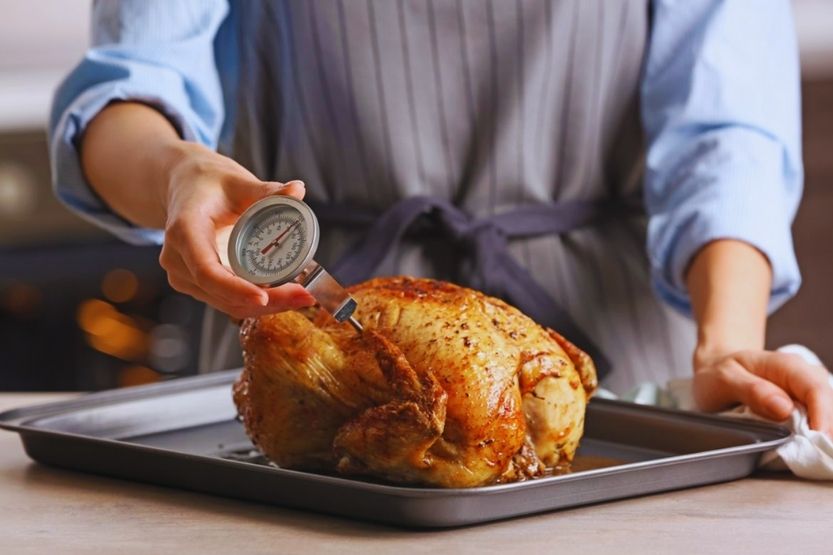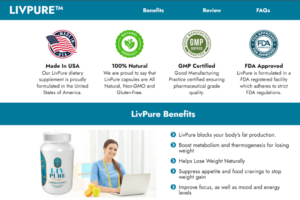If you handle and cook chicken properly, you can safely enjoy eating it. However, if you are an individual who loves to eat rare or medium-rare meat, you have to be careful. In this article, I’ll discuss medium-rare chicken – is it safe to eat?
Medium-rare chicken is not safe to eat because it is not fully cooked yet. It may still contain harmful bacteria that can make you sick. To ensure that it’s fully cooked, you can use a meat thermometer to check if the inside temperature is 165°F.
If you eat undercooked chicken, you are likely to get sick. Statistics show that around 1 out of 25 packs of chicken at the store are harboring salmonella. Rather than take the risk, you should cook it thoroughly. If not, it may cause cross-contamination with your other foods if you keep them in the fridge.
Read on to learn more about eating medium-rare chicken, whether it is safe, and things you need to consider if you want meat that is not fully cooked.
Medium Rare Chicken – Is It Safe to Eat?

Not Safe to Eat Medium-rare Chicken
No, it is not safe to eat medium-rare chicken. You should avoid eating undercooked chicken meat because there is a high chance that it contains harmful bacteria. You need to cook chicken meat fully.
Use a Meat Thermometer to Check If the Chicken Meat Is Fully Cooked
Use a thermometer to check if you have fully cooked the chicken meat. Poke its thermometer probe deep inside the cooked chicken meat. If the thermometer indicates 165°F, then you can safely eat it. If not, cook the chicken meat some more.
One Out of 25 Packages of Chicken at the Food Store Is Contaminated
You should be aware that out of every 25 packages of chicken at the food store, about one of them is contaminated with salmonella. This data came from the Centers for Disease Control and Prevention (CDC).
Risk of Ingesting Hundreds of Salmonella Bacteria
Is medium-rare chicken safe? If you haven’t fully cooked the chicken you are eating to 165°F, you risk ingesting hundreds of salmonella bacteria. I hope you know what happens to a person who eats salmonella together with the food they have eaten.
Cross-Contamination
Aside from that, if you have leftovers from that chicken and store them in your fridge, you will expose the other foods to these harmful bacteria. There will be bacterial cross-contamination with these other foods.
Exposure to Harmful Bacteria and Foodborne Diseases
Take the cue from Alina Jameson, an MS and RD from the University of Utah School of Medicine. Alina says that eating medium-rare chicken is not a safe practice.
People who like medium-rare chicken expose themselves to harmful bacteria and can get foodborne diseases.
A Bite of Bacteria-contaminated Chicken Can Get You Sick
Even just a bite of bacteria-contaminated chicken can get you sick. Toss the chicken back into the pan if you suspect you have an undercooked chicken. It’s better that way than getting hospitalized because of foodborne illness.
How Long Do Chicken Thighs Take to Cook?
What Type of Bacteria Is Present in Poultry That Is Harmful to Humans?
Ms. Jameson, the professor at UUSM, said that chicken raised conventionally in the United States is not “certified to be salmonella-free.” She advises that your safest option is to cook the chicken until it is well done.
The CDC also says that salmonella bacteria are not unusual for raw poultry, whoever the producer is. Poultry producers use antibiotics in their food processing facilities. Still, a salmonella outbreak occurred in 2014 in a giant chicken processing factory.
Nearly 700 people in 29 states and Puerto Rico were infected with salmonella. Eating medium-rare chicken in Japan could also have the same results if they are not careful.
If you are fond of eating undercooked chicken meat, it is not only salmonella bacteria that can make you sick. Other harmful organisms inside poultry have the same, or even worse, effects on the body. What are these dangerous organisms in raw poultry?
1. Salmonella
Responsible for the Infections of 1.35 Million People Every Year
In the United States, salmonella bacteria are responsible for the infections of 1.35 million people every year. They also caused 26,500 hospitalizations among those who were infected. These stats came from the CDC.
Salmonella bacteria, as you can see, are dangerous. They can cause salmonellosis, a foodborne disease. Some people get infected, then get well after treatment. Others have to go to the hospital for them to get well.
Symptoms of Salmonellosis
Some of the symptoms of salmonellosis are:
- Headaches
- Nausea
- Fever
- Vomiting
- Diarrhea
- Stomach cramps
Might Take Six Hours to Six Days to Start Feeling the Symptoms
It may take six hours to six days for you to start feeling the symptoms. Once you experience the symptoms, they will last four to seven days.
2. Campylobacter
Up to 1.5 Million People in the United States Are Infected Every Year
The CDC estimates that up to 1.5 million people in the United States obtain campylobacter bacteria every year. A person infected with campylobacter bacteria has campylobacteriosis.
Symptoms of Campylobacteriosis
Some of the symptoms of campylobacteriosis are:
- Vomiting
- Diarrhea
- Stomach cramps
- Fever
- nausea
Might Take Two to Five Days to Start Feeling the Symptoms
If a person eats chicken food contaminated with campylobacter bacteria, they will experience any of these symptoms within two to five days. The symptoms may last several days and up to one week.
24% of Chicken At Food Stores Is Contaminated
The National Antimicrobial Resistance Monitoring System found out in 2015 that around 24% of chicken meat available at food stores is contaminated with campylobacter bacteria. These bacteria can also cause cross-contamination with other foods if exposed to them.
This can happen if you use the same kitchen tools and equipment in preparing the chicken meat and your other food.
3. Clostridium Perfringens
A person can be infected with clostridium perfringens when they cook meat and then keep it warm for long periods before eating it. These bacteria can also exist on raw poultry. This bacterial infection also develops some symptoms in the infected person.
They include abdominal cramps and diarrhea. People infected with these bacteria don’t usually vomit or get a fever. The symptoms will appear from 8 to 12 hours of infection. They will only last less than 24 hours.
Consequences of Eating Medium Rare or Raw Chicken

The USA Food and Drug Administration recommends cooking your chicken until its internal temperature reaches 165°F. You can kill any harmful pathogen in the meat with this high heat.
If you insist on doing so, prepare yourself for the following consequences:
1. Contaminated Chicken Can Make You Sick
Is medium rare chicken breast safe? If you eat medium-rare chicken, there will still be many harmful bacteria in its meat that can make you sick; whose symptoms include:
- Muscle pain
- Fever
- Headache
- Abdominal cramps
- Nausea
- Diarrhea
- Vomiting
You will experience these symptoms within two to ten days of consuming contaminated chicken meat. Most of these symptoms will go away after four days.
Meanwhile, that you are experiencing the symptoms, you have to have some medication so that your illness will not get serious. Of course, you have to stop eating half-cooked chicken meat immediately.
2. Complications
Most people infected with bacteria from medium-rare chicken meat do not experience long-term health problems. However, those who have compromised immune systems may experience serious complications. They may even require hospitalization.
So, what are the possible complications of consuming medium-rare chicken contaminated with bacteria?
- Irritable bowel syndrome or IBS is a gastrointestinal illness that leads to changes in your bowel movements. It may include abdominal cramps.
- Guillain-Barre Syndrome or GBS is a rare neurological illness that can cause a person’s immune system to attack their peripheral nervous system. This illness can cause a person to experience muscle pain and muscle weakness. The person can also have issues with their coordination and balance.
- Acute dehydration
- Septicemia can occur when the body experiences an extreme reaction to an infection.
- Reactive arthritis – is a type of infectious arthritis.
Again, is it okay to eat medium-rare chicken? Eating a medium-rare chicken is not safe and can lead to foodborne illnesses.
What to Do After Consuming Contaminated Chicken Meat
If you think you have an infection upon ingesting a medium-rare chicken, you should first wait and see if you will experience the usual symptoms. You are not to induce vomiting since it may hurt your gut unnecessarily.
As advised by Poison Control, one of the first things you need to do is to hydrate yourself constantly. But if you find it hard to keep your fluids down, you should immediately call a doctor.
1. Seek Medical Help
A person should immediately seek help if they are suffering from bloody diarrhea. Those who are at higher risk may need to undergo antibiotic treatment. People who are at higher risk and get sick after consuming contaminated food include the following:
- Pregnant women
- People with compromised immune systems
- Children and infants below the age of 5
- Senior citizens who are more than 65 years old
2. Drink Plenty of Liquids
Generally, those who show symptoms of a sickness caused by the consumption of medium-rare chicken will get well after a few days without needing medical intervention.
Those infected should make sure that they drink plenty of liquids, especially those suffering from diarrhea and continuously vomiting.
In case of diarrhea, you should also drink lots of the following:
- Oral rehydration solutions
- Water
- Clear broths
- Sports drinks
- Diluted fruit juice
3. Ease the Symptoms Using Over-the-counter Medications
There are over-the-counter medications that you can use to help ease the person’s diarrhea. They include loperamide or Imodium. To reduce the person’s nausea, they can take bismuth subsalicylate like Pepto-Bismol.
4. Call a Doctor Immediately
An infected person should immediately seek medical help if they don’t retain fluids. Pregnant women, people who are more than 65 years old, children below five years old and infants, and those whose immune systems are already weak, should also call for a doctor immediately.
If the infected person shows the following symptoms, they should immediately seek medical help:
- High fever reaching around 102°F
- Little or no urination
- Blood stools
- Diarrhea that is continuously going on for three days
- Vomiting too frequently makes the replacement of fluids impossible
- Dizziness
How to Correctly Handle Raw Chicken

To ensure that you will not consume contaminated chicken, you need to know how to handle raw chicken properly. Careful food preparation is the key, along with the right cooking procedures. You should be aware that it is not just the consumption of raw chicken that can make you sick.
How you cook the way chicken meat also plays an important role. What you want to prevent is cross-contamination with your other food. You can prevent cross-contamination by doing the following:
- Return ordered chicken to the restaurant if it appears contaminated
- Put fresh chicken in a disposable bag before putting it in your shopping cart. This will prevent its juices from contaminating the other food on your cart.
- Store raw chicken meat on the lowest refrigerator shelf. Wrap it first with a plastic bag so that its juices won’t contaminate other food.
- Don’t put fresh or cooked food on any surface where you previously placed raw chicken meat.
- Wash your hands thoroughly before and after touching raw chicken.
- Put leftover chicken food inside the fridge within two hours after it has cooled down.
- Don’t wash raw chicken before preparing it. This will prevent bacteria inside it from spreading around.
- Always check if you thoroughly cook the chicken meat before serving it. Use a meat thermometer to do this. The inner part of the chicken meat should be at least 165°F.
- Only use one chopping board just for chicken meat.
- Thoroughly wash and clean all chopping boards, work surfaces, and utensils after preparing raw chicken.
How to Ensure Chicken Is Fully Cooked
The best way to avoid eating bacteria-laden chicken food is to make sure that it is prepared well and thoroughly cooked. These are the only ways to ensure that the meat will no longer harbor any bacteria that can make you sick.
Change in Color
While it is cooking, the pink color of the chicken meat will turn white. The meat’s texture will also change. You are advised not to eat chicken meat that is still pink in color since it is most likely undercooked.
Check the Internal Temperature
To be sure, always check the temperature of the inside parts of the chicken by using a meat thermometer. It should register 165°F on the scale. Poke the thermometer probe inside the thickest part of the chicken to ensure that every part is fully cooked.
You can also observe the color of the chicken meat. If it has already turned fully white, with no more traces of pink, it is cooked completely. With the 165°F temperature, you are now sure that the chicken is thoroughly cooked.
Frequently Asked Questions
You should know whether it is safe or not to eat medium-rare chicken since it can affect your health. If you read the following answers to the most often asked question about this topic, you will know if it’s safe to eat it or not:
Is It Safe to Eat Medium Rare Chicken?
According to the US FDA and the CDC, it is not safe to eat chicken cooked medium-rare. Raw chicken contains bacteria that can adversely affect your health. So, if you won’t cook chicken meat thoroughly, you are risking your health.
Cooking chicken medium rare will not kill these bacteria. If you eat them, they can multiply inside your body and make you sick. You need to check that the thickest part of the cooked chicken reaches 165°F before serving it on the table.
What Are the Chances of Getting Sick If I Eat Medium Rare Chicken?
The CDC says that for every 25 packages of chicken sold at the supermarket, one package contains salmonella. Just one small bite of this contaminated chicken, if not fully cooked, can send you to the hospital if your immune system is already weak. So, why take the risk?
A dietician and an instructor from the University of Utah School of Medicine, Alina Jameson, says that eating medium-rare chicken is likely not safe. It can lead to foodborne sickness, this dietician added.
What Can Happen to Me If I Eat Medium-rare Chicken?
If you consumed medium-rare chicken, with or without your knowledge, you could get sick because of the bacteria still inside the chicken. Some bacteria still living in the chicken include salmonella, campylobacter bacteria, and clostridium perfringens.
If the chicken meat is contaminated with any one of these bacteria, you can experience symptoms like:
- vomiting
- muscle pain
- nausea
- headache
- fever
- abdominal cramps
- diarrhea
If your condition worsens, you may even require hospitalization, especially if you are more than 65 years old, pregnant, and have already compromised your immune system. You should not feed infants and small children with medium-rare chicken because they can’t withstand these symptoms.
In Closing: Is It Safe to Eat Medium Rare Chicken?
It is not safe to eat medium-rare chicken because the meat may not be fully cooked yet. There could still be some harmful bacteria in the meat that can make you sick. You need to be sure that the meat is fully cooked before eating it.
To do that, you have to use a meat thermometer. If the inside parts of the cooked chicken reach the temperature of 165°F, you can eat it. But if it’s lower than that, cook the meat some more.
Read next:
How Long Does It Take to Boil a Whole Chicken?
How to Deep Fry Chicken Wings? How Long Does it Take?







